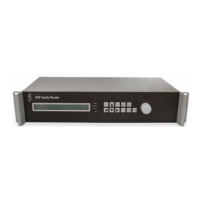VAR8 and Variants - Product Description
Issue: 02 complete, approved
Page 24 of 54
In the event of such a fault, the volume will default to that set up on position ‘off’, i.e. the maximum level.
The same default operation occurs in the event of RS485 communications failure to the Remote I/O Unit.
L
Only one Volume Control should be configured to govern an input in respect of a single output.
If two Volume Controls are configured to govern the same input in respect of an output, then the
results are unpredictable.
2.6.3.3.3 Ambient Noise Sensors (ANS)
The purpose of an ANS system is to adjust the level of public address announcements based on a measure
of the ambient noise in the target zone. This is intended to maintain a set volume of public address audio
above the ambient noise, in order to guarantee that the announcement is intelligible, yet at a comfortable
level.
The ANS sensor (ASL ANS01, ANS02, ANS03, or ANS04) is an analogue device that produces a DC
voltage proportional to the measured ambient noise level.
The DC voltage is received via the Remote I/O Unit analogue channel, and is translated to a value of
measured ambient noise in dBA. This value is used to proportionally adjust the Router output gain for the
configured output channels.
The Router is set up for the maximum broadcast volume without the ANS, and the ANS system then reduces
the gain from this level when the zone is quiet.
In the ANS setup, a minimum threshold value of ambient noise (in dBA) is programmable to each output.
This is used to limit the range over which the gain may be reduced. When the ambient noise reaches or is
below this value, the Router applies the maximum reduction to the output gain. Therefore this has the
minimum gain, and a lower ambient noise will not reduce the broadcast volume further.
A maximum threshold value of ambient noise (in dBA) in the zone is also programmable to each output.
When the ambient noise reaches or exceeds this value, the Router applies the full configured output gain for
the zone.
A software configurable ‘Attack Time’ is programmable for each output channel. The Attack Time controls the
rate at which the Router can increase the gain when the ambient noise rises. This is to stop the ANS system
from suddenly increasing the broadcast volume in response to any short-term increases in ambient noise.
It is possible to configure a particular ANS sensor to control one, or any group of, Router outputs, and it is
possible for more than one ANS sensor to be used to control the gain in a single zone.
It is possible to assign up to 12 ANS sensors to a single Router output (provided that the
sensors are connected to the same BMB01 Remote I/O Unit). Where this is done, the highest of
the received ANS values is used, i.e. the maximum volume required by any to the ANS sensors
is used.
!
!
The ANS system can be set to act on different audio sources in different units. For normal audio sources the
ANS level is frozen and does not change during each announcement into a zone. This so that the broadcast
itself is not ‘heard’ by the ANS sensors as an increase in the ambient noise level. Without this function the
ANS system would cause the broadcast volume to increase during each broadcast. However some input
sources can be set to not have the ANS level frozen during broadcast, such as background music. These
sources must be set so that their maximum volume is below the maximum ANS threshold (in dBA).
It is possible to disable the ANS function per output channel for system test purposes.
The diagram in Figure 8 illustrates the ANS operation.

